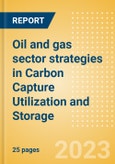A steep reduction in emissions is required over the next decade to keep the 1.5 degree warming scenario alive. Carbon capture, utilization, and storage (CCUS) is one of the few technologies that can avert existing emissions and remove carbon dioxide that has accumulated in the atmosphere.
Global CCUS capacity is expected to reach 506 mtpa by 2030, which represents a CAGR of 38% between then and now. However, despite this growth, CCUS technology is not scaling quick enough.
CCUS represents an important opportunity for the oil and gas industry, allowing ongoing emissions to be mitigated, helping the sector to balance energy security with decarbonization, as well as having the potential to remove carbon dioxide from the atmosphere.
Oil and gas players will continue to dominate company capacity rankings in 2030, but Exxon Mobil will replace Occidental Petroleum as the market leader, reaching a capacity 31.2 mtpa by the end of the decade.
Oil and gas players that build their capability across the full suite of CCUS technologies, especially direct air capture, will be in the strongest position as countries continue to decrease their reliance on fossil fuels.
Key Highlights
CCUS represents an important opportunity for the oil and gas industry, allowing ongoing emissions to be mitigated, helping the sector to balance energy security with decarbonization, as well as having the potential to remove carbon dioxide from the atmosphere.Oil and gas players that build their capability across the full suite of CCUS technologies, especially direct air capture, will be in the strongest position as countries continue to decrease their reliance on fossil fuels.
Between 2030 and 2070, CO2 reductions from CCUS are expected to increase from 0.6Gt to 6.89 Gt, representing a CAGR of 6.3%.
The number of active projects is expected to rise from 66 in 2023 to 285 by the end of the decade.
A major shift towards post-combustion capacity is expected between now and 2030, with this technology type dominating 65% of active capacity by the end of the decade. Oil and gas players should consider increasing their capability in this area in order to capitalize on the wider decarbonization of a number of industries that represent point sources of emissions.
High capital costs have created a barrier to entry, resulting in the top 10 companies accounting for over 75% of total active CCUS capacity. As a result, the oil and gas sector currently accounts for the majority of active CCUS capacity.
Scope
- CCUS emission reduction potential
- CCUS technology briefing and value chain
- Total CCUS capacity over time
- Breakdown of CCUS capacity by capture technology in 2023 and forecasted in 2030.
- CCUS capacity by country and key policy developments
- CCUS capacity by company in 2023 and 2030
- Top 10 CCUS projects in 2030 by capacity
- Locations of the world’s largest CO2 storage sites in 2030.
- CCUS deal activity within oil and gas
- CCUS hiring trends in oil and gas
- CCUS within oil and gas company filings
Reasons to Buy
- Understand the key trends and challenges within the CCUS market
- Identify the key countries and players for CCUS capture and storage capability.
- Develop market insight of current, in development and announced capacity and latest trends of the sector.
- Understand how the oil and gas sector is engaging with this technology through upcoming capacity as well as alternative datasets such as deals, hiring and company filings trends.
Table of Contents
- Emission reduction through CCUS
- The Oil and Gas CCUS strategy
- CCUS technology types
- The CCUS value chain and OG’s focus areas
- The strategic value of CCUS in the face of industry challenges
- CCUS market outlook
- The CCUS project outlook
- Technological shift in the CCUS market
- Country ranking and key policy developments
- Oil and Gas CCUS capacity
- Current leaders in CCUS capacity
- Leaders in CCUS at the end of the decade
- Largest capture projects by 2030 capacity
- Largest storage projects by 2030 capacity
- CCUS market signals in oil and gas
- Deal activity
- Hiring trends
- Corporate filing trends
Companies Mentioned (Partial List)
A selection of companies mentioned in this report includes, but is not limited to:
- Occidental Petroleum
- Exxon Mobil Corp
- Basin Electric Power Cooperative
- Canadian Natural Resources
- Chevron Corp
- Air Products and Chemicals Inc.
- QatarEnergy
- ENEOS Corporation
- Shell Plc
- Sinopec
- Equinor ASA
- Eni S.p.A
- Enhance Energy Inc.
- Summit Agricultural Group
- Santos Ltd.
- Drax Group Plc
- Enchant Energy Corp
- Prairie State Energy Campus LLC
- Bakken Energy LLC
- Mitsubishi Heavy Industries Ltd
- Oil and Natural Gas Corp
- Saudi Arabian Oil Co
- ConocoPhillips
- BP Plc.








